Undoubtedly, the most important thing in the bathroom is heating. However, this aspect depends not only on the presence of heat-insulating materials or special heating systems. Everything concerns the bath must be thought out as carefully as possible.
In this material it will be about installing a warm floor. It must be said that this is an important thing that allows bath visitors to feel comfortable even if the frost is outside. And indeed, our feet are most sensitive to any temperature drops, and this is especially dangerous if the floor is cold.
Fortunately, modern technologies make it possible to establish compact and practical heating systems even at the floor level. A couple of dozen years ago it was possible to dream about such.
If we install in the bath with autonomous heating, we warm the room, as well as install a warm floor, then in our hands control over the temperature situation in the entire bath, and with this situation, no threat is not even the strongest frost outside the window.
In the article we will talk about how to better install a warm floor, as well as consider all the details of the installation process. Moreover, we will try to analyze the main features of the warm floor in the bathroom.
Features of using a warm floor
To date, the warm floors are used in almost any rooms and any rooms. This confirms the words that this is a practical solution that makes the stay in the room more cozy and really comfortable. It is important to keep in mind that if possible, it is necessary to install a warm floor, since in the winter period this system will only positively affect the well-being, as well as the mood of family members. It should be remembered that the warm floor is not the cheapest pleasure, so it can afford it is not all.
The main advantages of the warm floor are the following:
- The best option for floor heating. There are quite a few options for heating the floor surface, however, it is the modern (electric, film and water systems) versions of this equipment provide practical operation. Of course, practically no complaints of such a warm floor causes.
- Temperature regulation. Modern warm floors, as already mentioned, are incredibly practical in use. Accordingly, it is possible to easily adjust the heating temperature of the floor, and in some cases the temperature mode can be changed automatically, for example, depending on weather conditions.
- Durability of equipment. Many manufacturers who are engaged in the release of water warm floors argue that their products will work without complaints over half a century. And this is not a joke, since the technologies used are really distinguished by high durability and reliability.
- Security. Most of the warm floors have a low heater temperature. This suggests that there is no threat to expect. Despite this, modern installations provide a decent heating, which will notice for residents and guests at home.
Of course, have warm floors and some drawbacks:
- Long-term foundation on the warm floor is not recommended. It is known that the constant contact of the feet with a warm floor can adversely affect human health. We are talking about vascular diseases of the legs. It must be borne in mind and not too often use this benefit. If you like to walk barefoot, it is best to warm up the floor in the morning, and for a few hours it will remain warm. People who go to the sneakers are hardly threatened. As for the bathroom, people spend not so much time in it, so there's nothing to worry about.
- Energy costs. Of course, the warm floor consumes energy that is subsequently turning into heat. However, most of the modern installations use not so much electricity. Especially good if the bath is used for the appointment not so often, then it should not be thought about this issue.
This is not all the advantages and disadvantages of a warm floor. There are still quite a variety of details that need to know, but all of them depend solely on the specifics of the room, as well as the scale of heating.
It should be prepared for the fact that when installing a warm floor, unpleasant moments will be detected, significantly complicating the process of installing all equipment. For example, it may be too low ceilings (since the floor needs to be lifted), or furniture that adversely perceives heating.
Existing Warm floors
- Electric heating. In this case, the so-called "cable floors", or film surfaces that feed on the source of electricity and heat the floor are used. It is worth saying that this is the most practical option that does not imply the installation of some massive devices (in contrast to another option).
- Pipeline circuit. It uses a liquid coolant, which circulates using a pumping unit. Often, ordinary water is used as a coolant, but sometimes even antifreeze is used.
First of all, it is worth understanding that the pipeline circuit is not the best option for the reason that the boiler is needed for this system, as well as the pump. Without this, the system will not function. Obviously, with such a situation, it is necessary to think about the allocation of a special place for all this equipment. However, it is not necessary to think that the water system is the worst option for heating the floor. If you compare electrical and water heating, then the second option is more attractive in terms of energy efficiency. However, the savings will give themselves to know only a few years after the start of operation.
The components of a warm floor
Classic warm floor is not only heating elements located under laminate or parquet. First of all, the thermal insulation material is placed on the surface, on top of which a warm floor is installed, after which the "dry" or cement screed is created. Moreover, today specialists recommend using and waterproofing, which will save from unpleasant situations. This is especially true in the bathroom, where there is a lot of moisture and water.
Waterproofing is often a conventional polyethylene film, however, it is most important to visually inspect the surface of this material for damage. Any scratches or other damage may reduce the efficiency of waterproofing to a minimum.
Warm floor based on electrical cable
The cable of this unit has a small thickness, but the effectiveness of such a system is quite high. Accordingly, the principle of operation of such a system is to transform electricity to heat, which is evenly distributed over the entire length of the cable. As for the specific heat dissipation by 1 square meter, then for the bath, this value should not exceed 250 W. On systems that are available on sale, indicates this information, but additionally, you should ask all the questions you are interested in the consultant.
Such warm floors also have temperature control sensors. Accordingly, with the help of the thermostat, we can not only implement the desired value for heating, but also use automatic modes.
Experts recommend putting such a warm floor under linoleum. In addition, the concrete surface also perfectly carries out heat. As for wooden surfaces, there may be problems associated with fire safety. In such conditions, the installation of a warm floor should be carried out particularly carefully and responsibly. Any connections and joints must be isolated.
Accordingly, the installation process consists of the following steps:
- There is a complete disassembly of the floor, after which the installation of thermal insulation is carried out.
- Next occurs uniform laying of the cable throughout the perimeter of the room. Thanks to the exact location of heating elements, we are guaranteed to obtain an excellent results of the system.
- Mounting cable to the floor occurs with the mounting tape. You can also use other fasteners, however, it is often enough tapes. In addition, the temperature sensor can be fixed using the assembly material.
- For additional reliability over a warm floor, you can place a metal mesh. The thermostat is installed on the wall nearest to the temperature sensor.
- After that, a cement-sand screed is created, which should have a small thickness. A month later, the screed will type the necessary strength, after which it is possible to safely install the floor covering.
Immediately before creating a screed, the system should be experiencing several times to make sure that everything works flawlessly. Obviously, if there are problems, corrected the situation after creating a screed will be incredibly difficult, as well as expensive.
Floor heating system
Film floor is the most inexpensive and effective solution. In this case, we have infrared radiation that can warm the floor well. This warm floor is produced in rolls. Accordingly, even the installation of this material is extremely simple. Moreover, there is no need to create a cement screed, as in the past case.
Thus, the process of furnaceing the film based on the film consists of the following steps:
- Infrared matte installation occurs. They have a small thickness that allows them to have enough bottlenecks.
- Immediately after this, you can pour tiled glue, which will be the gap between the film and the main surface of the floor.
It should be borne in mind that this warm floor can be laid under wooden surfaces (parquet, laminate) without restrictions. In some cases, the installation process of the warm floor is limited exclusively by mounting a single infrared mat. However, builders still recommend creating an aligning layer, which in this case represents tile glue.
You can additionally install insulating layers, but in this, again, there is no need, especially if the room has small dimensions.
To the considerable amount of advantage of film warm floor can also be attributed to a small thickness of the surface of the surface. Together with insulating layers, such a warm floor has a thickness of no more pair of centimeters, which is very good for housing with low ceilings.
Warmland arrangement
It is a water warm floor that has the highest complexity of the work. It should be noted the fact that most often the water floor is poured by a concrete tie. This is the most reliable way, but at the same time you need a lot of time to set concrete.
Overheating such a system does not threaten. Moreover, the principle of laying heating elements can be arbitrary, but it is necessary to have them evenly and with a certain step.
Laying occurs on waterproofing. You can pre-arrange on the surface of the floor and thermal insulation. It should be borne in mind that any flaws of waterproofing material are not allowed.
Further, as in the case of an electrical cable, the elements of the water floor are located all over the perimeter of the room. Again, a mounting tape is used for fastening the tubes. In addition, you will have to place the temperature sensor and the thermostat. All this should be located at a convenient and affordable place.
After that, the system is tested. If everything is fine, then you can start creating a concrete screed. It is also no need to forget that warm water comes from a special boiler. Thus, you need to bring all the necessary elements of the system to the warm floor.
Concrete screed gains strength for several weeks. Throughout this time, it is not desirable for this time. Also can not be allowed sharp temperature drops, as it will negatively affect the state of concrete and the screed in general.

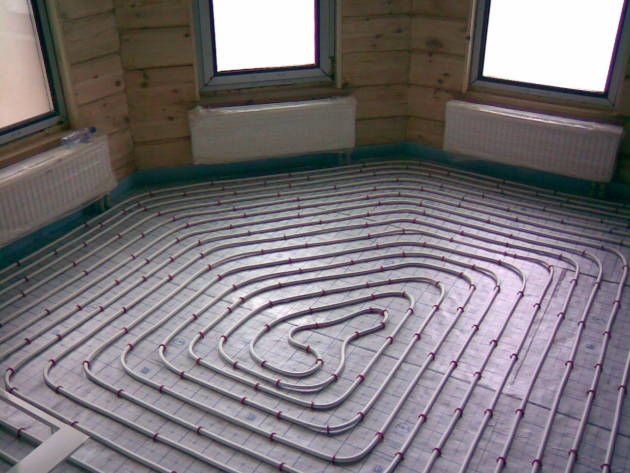
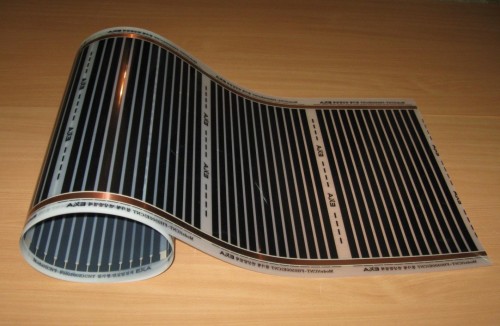
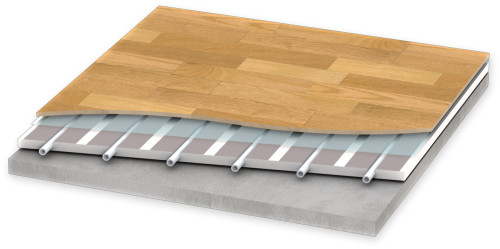
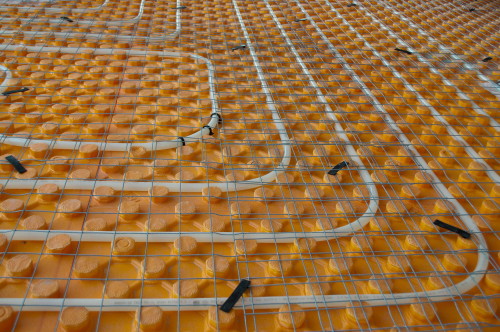


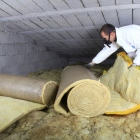
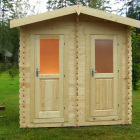



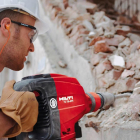
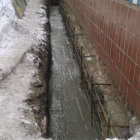
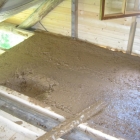
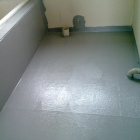
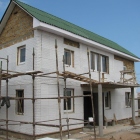
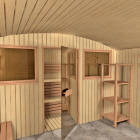
 Start a discussion ...
Start a discussion ...